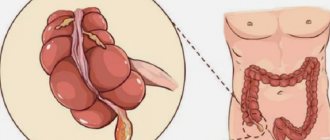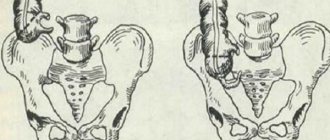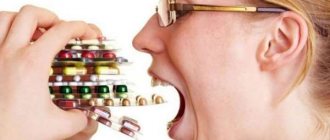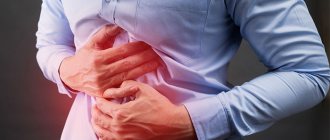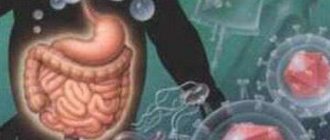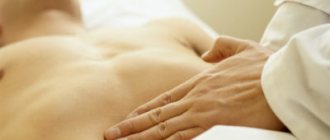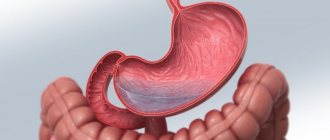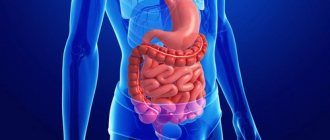Gastroenterocolitis is a condition in which an inflammatory process in the stomach is diagnosed, affecting both the large and small intestines.
According to the international classifier, gastroenterocolitis belongs to the category of toxic infections. ICD 10 code for gastroenterocolitis is K 52.
When symptoms of gastroenterocolitis appear in adults, treatment of the disease should be carried out in a timely manner so that it does not become chronic and does not provoke serious complications.
Causes of the disease
The main cause of gastroenterocolitis is called toxic infection. Its causative agents are salmonella, listeria, rotavirus, echovirus, shigella and some other pathogenic microorganisms.
The infection is transmitted through poor-quality food and water, non-compliance with sanitary standards, during food preparation, causing signs of gastroenterocolitis. Also, infectious gastroenterocolitis can develop with sepsis and chronic infectious diseases.
Non-infectious diseases are associated with drug allergies, salts of heavy metals, and certain acids. The chronic form can be caused by a protracted course of diseases of the digestive tract associated with inflammatory processes.
In certain cases, gastroenterocolitis can be hereditary. Risk factors that can cause the first signs of the disease include:
- lack of vitamin B;
- hypothermia, too cold food and food;
- regular stressful conditions;
- constant consumption of rough food.
Prognosis and prevention
The prognosis is favorable . The acute form usually lasts up to a week. For a complete and speedy recovery, diet is of great importance. However, final restoration of digestive function may take up to 6 weeks.
However, the development of diseases such as gastritis and enterocolitis (in their chronic form) after gastroenterocolitis is possible if the episode of the disease was preceded by cases of stomach or intestinal diseases, helminthiasis and other gastrointestinal diseases.
Among the preventive measures:
- compliance with sanitary and hygienic standards for food storage and preparation,
- following the rules of personal hygiene,
- rational nutrition and its regime.
Forms and types of pathology
Depending on the course of the inflammatory process, the following types of disease are distinguished:
- Hemorrhagic. Vascular disorders form in the mucous layer in the form of erosions, hemorrhages and inflammations.
- Catarrhal. Swelling of the mucous membrane is observed, and the secretion of exudate increases.
- Ulcerative. The presence of ulcerative formations is characteristic.
- Fibrous. A rare species that is distinguished by the presence of fibrous films.
- Phlegmonous. It is expressed not only by the inflammatory process, but also by the formation of purulent accumulations.
- Uremic gastroenterocolitis. This species can cause uremia (increased uric acid nitrogen).
Statistics show that the most common forms are catarrhal and hemorrhagic gastroenterocolitis.
According to severity, gastroenterocolitis is divided into:
- Sharp form. Acute gastroenterocolitis, as a rule, occurs against the background of an infection that enters the gastrointestinal tract or as a result of an allergic reaction.
- Chronic form. Develops due to diseases of the digestive system.
What types of inflammation occur?
Based on the type of process, the resulting inflammation can be divided into the following forms:
- Hemorrhagic form. In this case, erosive-hemorrhagic defects of the mucous membrane occur in the digestive system. The small intestine is susceptible to such lesions due to toxic infection.
- Phlegmonous form. The nature of such inflammation is purulent. Its danger is that inflammation can extend beyond the mucous membrane, involve the entire thickness of the intestine and lead to its perforation.
- Catarrhal form. As inflammation develops, redness and swelling of the inner layer of the digestive tract occurs. As a result, a large amount of liquid – exudate – is released into the lumen.
- Ulcerative form. It is of this nature that defects in the gastrointestinal mucosa are observed.
- Fibrinous form. In this case, films consisting of fibrin are formed.
Symptoms of the disease
The disease is characterized by a rapid incubation period, which can develop either a few hours after infection or after 2-3 days.
At the beginning of the disease, weakness, loss of appetite, and nausea may occur.
As the disease progresses, the symptoms of gastroenterocolitis appear as follows:
- bloating and rumbling in the intestines;
- a sharp decrease in appetite;
- vomiting and diarrhea, which can occur both in the first days of illness and occur after a few days. Moreover, before the onset of diarrhea, stool may be in the form of constipation;
- the presence of blood streaks in the stool;
- pain in the abdominal area, cramping or pulling;
- belching, bitterness in the mouth;
- headache, chills, fever;
- intestinal flu.
The chronic stage is less pronounced; during exacerbation, nausea and vomiting, abdominal pain, flatulence, etc. occur.
It must be remembered that timely treatment of early symptoms of gastroenerocolitis prevents the risk of the disease becoming chronic.
General information
Gastroenterocolitis is an inflammatory lesion of the stomach, large and small intestines. The disease can be acute or chronic. Acute gastroenterocolitis responds well to treatment if the true source of the pathology is quickly identified and eliminated. In chronic cases, special attention is paid to lifestyle correction and diet. Acute gastroenterocolitis in severe cases requires a 24-hour hospital stay, mild forms are treated on an outpatient basis. The code for gastroenterocolitis according to ICD-10 is K52.
Diagnostics
Before prescribing treatment for gastroenterocolitis, the specialist listens to the patient’s complaints, clarifies the symptoms of the disease, and also conducts an examination. To establish an accurate diagnosis, the gastroenterologist prescribes a laboratory examination, which includes:
- biochemical and general blood test;
- stool examination;
- coprogram;
In certain cases, for a more accurate diagnosis, it is possible to perform an ultrasound of internal organs, colonoscopy and irigoscopy. This technique helps to accurately determine the degree of damage to the intestines and the changes occurring in it. If necessary, a tissue biopsy may be prescribed.
Diagnostic scheme
To make a diagnosis and identify the cause of gastroenterocolitis, the following methods are used:
- Examination by a therapist or gastroenterologist. A primary diagnosis can be made based on a typical clinical picture.
- General and biochemical blood test. In chronic gastroenterocolitis, anemia and failure of lipid metabolism are observed. In the acute stage, a disturbance in the ionic balance of the blood is possible.
- Coprogram. Stool examination allows you to evaluate the functioning of the digestive tract.
- Bacteriological culture of stool. Used when the infectious nature of the disease is suspected. Allows you to identify the causative agent of gastroenteritis.
For chronic damage to the digestive tract, other methods are added:
- Fibrogastroduodenoscopy. Used to diagnose lesions of the stomach and duodenum.
- Colonoscopy is an endoscopic examination of the intestine. Allows you to see the mucous membrane from the inside, identify tumors, ulcers, polyps, and signs of inflammation. During a colonoscopy, a small section of the mucous membrane is removed for histological examination.
- Sigmoidoscopy is an endoscopic method for diagnosing diseases of the final sections of the colon.
- X-ray examination. Allows you to identify defects in the intestinal wall or space-occupying formations and assess the patency of the organ.
Be sure to read:
Ileocecal valve (Bauhinian valve): concept, location, structure and functions
Treatment of gastroenterocolitis in adults
In mild cases, treatment of gastroenterocolitis is carried out at home under the supervision of a specialist. During the acute form, the patient must be hospitalized.
In order for the treatment process to be effective, you need to know how to treat gastroenterocolitis.
Basic therapy for the pathology includes:
- Antibacterial agents. Infectious forms of gastroenterocolitis require medications such as Ampicillin, Levomicillin, etc.
- Dehydration. An event that helps eliminate dehydration when treating illness in adults. For mild cases, saline solutions of Regidron and Oralit are mainly used. In more severe cases, they resort to intravenous administration of Disol, Chlosol, etc.
- A detoxification procedure that helps remove toxins from the body. With this treatment, gastric lavage is carried out using bicarbonate, and it is also possible to use potassium permanganate. In case of constipation, enemas or laxatives are used.
- Symptomatic therapy. When treating gastroenterocolitis, drugs are used in the form of tablets or other dosage forms that eliminate pain, normalize digestion and strengthen the immune system.
Treatment
Both in the acute period of G. and in the period of convalescence, a decrease in functional loads on the organs of the digestive system, in particular on the intestines, is shown; This is achieved by a diet and a gentle diet. Food should be taken 4-5 times a day, warm, in small portions. On the 1st-2nd day of illness, the patient’s diet is usually sharply limited: slimy rice or oatmeal soups, weak meat broth, liquid porridge in water with butter, fruit and berry jelly or jelly, white crackers. Drinking (unsweetened tea with lemon, still alkaline mineral water, blueberry and rosehip decoction) is not limited. In case of severe intoxication, only drinking (up to 2 liters) is recommended for 1-2 days. From the 3-4th day, when the patient’s condition improves, the patient is transferred to diet No. 4 (see Medical nutrition), and after 7-10 days - gradually to normal nutrition.
Gastric juice and enzyme preparations are indicated to help normalize digestion and absorption. To restore homeostasis, the disturbance of which is mainly associated with the loss of significant quantities of water and salts, the introduction of salt solutions in large volumes corresponding to the losses is required. Typically, dehydration in G. is isotonic and extracellular in nature. For the purpose of rehydration, the use of Trisol, Quartasol and Ringer solutions is more justified.
For detoxification, drip intravenous infusion of isotonic solutions of salts and glucose (up to 2-3 l), hemodez (100-250 ml), blood plasma or its substitutes (100-200 ml), hydrocortisone (125 mg) or prednisolone (30 mg) is performed. . If the presence of bacterial toxins is suspected, gastric lavage is performed. Tetracycline drugs, ampicillin and chloramphenicol, as well as derivatives of nitrofuran (furazolidone) and 8-hydroxyquinoline (enteroseptol, 5-NOK) are used. The use of astringents, enveloping and adsorbing agents is indicated.
The use of antihistamines and antiallergic drugs (suprastin, pipolfen, diphenhydramine, stugeron) is important, especially in allergic diseases. For dysbiosis, biol is prescribed, drugs that help restore normal intestinal flora (colibacterin, bifidumbacterin, bificol).
Diet for gastroenterocolitis in adults
An important measure during recovery in adults is proper nutrition and adherence to a special diet. To do this, you need to know the recommended and excluded foods and dishes that can be consumed during illness.
In the first days of illness, only liquid is taken. Then foods that do not irritate the mucous membrane are introduced, such as porridges, casseroles, and jelly. After an acute period with gastroenterocolitis, the dietary table may include: low-fat steamed cutlets, eggs, fish, weak broths, vegetables.
It is necessary to exclude from the diet:
- spicy, fried and fatty foods;
- raw vegetables and fruits;
- foods that cause fermentation.
The same nutritional principles should be followed when treating a chronic illness.
Acute gastroenterocolitis treatment
Treatment of acute gastroenterocolitis depends on the cause of the disease, its intensity, the age of the patient and his condition at the time of examination. Therapy is prescribed by a doctor. When diagnosing adults, the following is carried out:
Rinsing is carried out until there are no food fragments left in the released liquid.
This procedure significantly reduces the number of pathogens in the body and improves the prognosis. Gastric lavage. For this, water or a weak solution of potassium permanganate can be used. Rinsing is carried out until there are no food fragments left in the released liquid. This procedure significantly reduces the number of pathogens in the body and improves the prognosis.- Fighting the pathogen . For bacterial processes, antibiotic therapy is carried out, for viral processes, antiviral treatment, etc.
- Treatment with antispasmodics . In case of significant spastic phenomena, they not only relieve pain, but also reduce swelling of the gastrointestinal mucosa.
- Replenishment of blood volume . In the absence of vomiting and slight loss of fluid, you can stop drinking plenty of fluids. The use of Regidron is preferable. If dehydration is significant, it is necessary to resort to intravenous solutions.
- The patient must be covered and heating pads placed on the stomach.
- If necessary, saline laxatives are used.
In addition, treatment is prescribed depending on the symptoms that accompany gastroenterocolitis. It is recommended to take any drug for diarrhea. If constipation often occurs, you can take laxatives. Painkillers will help eliminate spasms and pain: Drotaverine, Spazmalgon. In some cases, it may be necessary to use enzymes and drugs to improve intestinal motility. To improve the patient’s well-being, he is recommended to take a complex of vitamins.
Etiology of the disease
The main reasons for the development of gastroenterocolitis include:
- Infection with bacteria (Salmonella, Shigella, Ischerichia and other enteropathogenic strains, as well as opportunistic Proteus and Escherichia coli);
- Viral infections (human rotavirus, which causes intestinal flu, ECHO virus, Norvalk agent of viral gastroenteritis, etc.);
- Drug and food allergies;
- Toxins (intoxication with heavy metals, alcohols, acids and alkalis);
- Other infections.
Note: predisposing factors that provoke the development of the disease may be the abuse of foods with large amounts of coarse fiber, cold drinking and hypothermia, increased acidity and vitamin deficiencies.
Symptoms
Pain in the upper abdomen around the navel.
The disease begins suddenly, with characteristic symptoms of gastrointestinal dyspepsia. Patients complain of belching, heartburn, heaviness in the pit of the stomach, as well as diffuse pain or pain localized around the navel and in the upper abdomen. Very often, vomiting of food occurs, stool retention for 1-2 days, and then diarrhea develops.
At the same time, with gastroenterocolitis, there are symptoms of general intoxication: increased body temperature, headaches, confusion, as well as cardiovascular disorders. In medical practice, there are cases when the disease occurs with mild or completely absent dyspeptic symptoms. Then signs of general intoxication come to the fore.
As a rule, with timely treatment, the acute form of the disease passes very quickly, leaving no consequences. In more severe cases, the disease can last about two weeks, turning into recurrent chronic gastroenterocolitis.
Signs of gastroenterocolitis in children
There are many causes of this disease in childhood. Along with food toxic infections, it can be triggered by an increase in the virulence of the intestinal microflora (especially Proteus and E. coli), as well as a decrease in the child’s body’s resistance under the influence of various factors.
Often, gastroenterocolitis in children develops against the background of catarrh of the respiratory tract, like parenteral dyspepsia, but in this case the pathological process is delayed for a longer time.
Due to the aggressive influence of microorganisms located in the intestine, its mucous membrane becomes inflamed, that is, the dyspeptic process is replaced by a catarrhal process.
Note: Sometimes, under the guise of this pathology, a typhoid process may develop in young children, accompanied by symptoms of leukopenia and a positive Widal reaction. However, most often the disease in children under 3 years of age is caused by a dysentery bacillus.
The main symptoms of acute gastroenterocolitis in children include stool disorders and signs of general intoxication. From the first day of the development of the disease, the patient’s stool contains a large amount of mucus and even some streaks of blood. Most children's stools are dark green in color, comparable to the color of frog spawn or swamp mud. In especially severe cases, symptoms of distal colitis are observed (tenesmus, anal compliance, spasms of the sigmoid colon).
Children also develop infrequent but persistent vomiting, and the temperature rises from the very first day of illness. It reaches its maximum values in the first three days, then lasts for a week and declines.
Note: there are many different forms of enterocolitis characteristic of childhood, and therefore in clinical practice they are usually grouped according to common characteristics:
- Rapid or gradual transition to the chronic stage.
- Malignant course of the disease and high mortality.
- Pronounced contagiousness (infectiousness).
- Negative results of bacterial cultures.
Note: the latter is usually associated with a viral etiology of the disease or treatment with antibiotics.
Sometimes during a flu epidemic, children under three years of age (and older) may develop influenza gastroenterocolitis. This form of the disease is characterized by a very rapid course with an initially high temperature and complications such as pyuria, otitis and pneumonia.
If your pet's digestion has worsened, vomiting and diarrhea have appeared, or the dog is whining, then this is a reason to seek help from a veterinarian. There is no need to wait for everything to go away by itself. As a rule, such symptoms mean one thing – gastroenteritis in dogs. Let's study this disease in more detail and see how to properly cure it.
